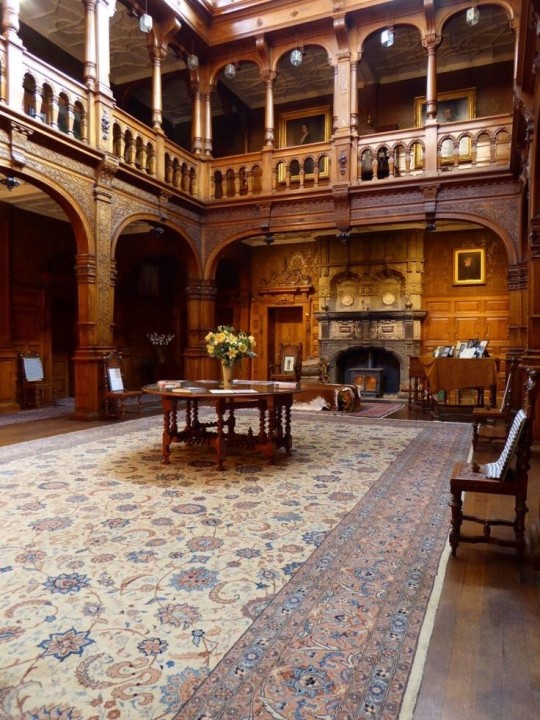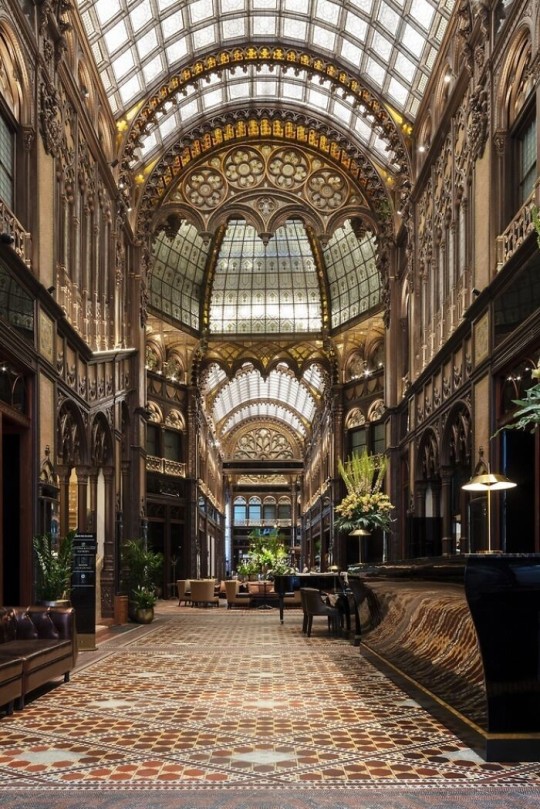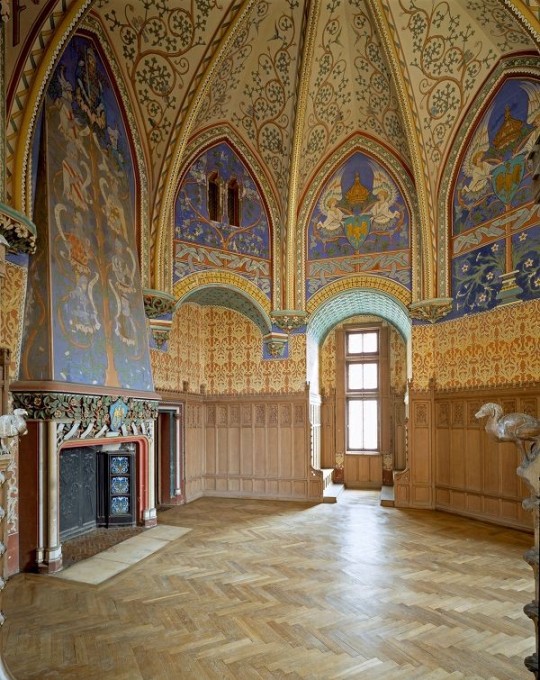Text
Fantasy Guide to Interiors





As a followup to the very popular post on architecture, I decided to add onto it by exploring the interior of each movement and the different design techniques and tastes of each era. This post at be helpful for historical fiction, fantasy or just a long read when you're bored.



Interior Design Terms
Reeding and fluting: Fluting is a technique that consists a continuous pattern of concave grooves in a flat surface across a surface. Reeding is it's opposite.
Embossing: stamping, carving or moulding a symbol to make it stand out on a surface.
Paneling: Panels of carved wood or fabric a fixed to a wall in a continuous pattern.
Gilding: the use of gold to highlight features.
Glazed Tile: Ceramic or porcelain tiles coated with liquid coloured glass or enamel.
Column: A column is a pillar of stone or wood built to support a ceiling. We will see more of columns later on.
Bay Window: The Bay Window is a window projecting outward from a building.
Frescos: A design element of painting images upon wet plaster.
Mosaic: Mosaics are a design element that involves using pieces of coloured glass and fitted them together upon the floor or wall to form images.
Mouldings: ornate strips of carved wood along the top of a wall.
Wainscoting: paneling along the lower portion of a wall.
Chinoiserie: A European take on East Asian art. Usually seen in wallpaper.
Clerestory: A series of eye-level windows.
Sconces: A light fixture supported on a wall.
Niche: A sunken area within a wall.
Monochromatic: Focusing on a single colour within a scheme.
Ceiling rose: A moulding fashioned on the ceiling in the shape of a rose usually supporting a light fixture.
Baluster: the vertical bars of a railing.
Façade: front portion of a building
Lintel: Top of a door or window.
Portico: a covered structure over a door supported by columns
Eaves: the part of the roof overhanging from the building
Skirting: border around lower length of a wall
Ancient Greece
Houses were made of either sun-dried clay bricks or stone which were painted when they dried. Ground floors were decorated with coloured stones and tiles called Mosaics. Upper level floors were made from wood. Homes were furnished with tapestries and furniture, and in grand homes statues and grand altars would be found. Furniture was very skillfully crafted in Ancient Greece, much attention was paid to the carving and decoration of such things. Of course, Ancient Greece is ancient so I won't be going through all the movements but I will talk a little about columns.
Doric: Doric is the oldest of the orders and some argue it is the simplest. The columns of this style are set close together, without bases and carved with concave curves called flutes. The capitals (the top of the column) are plain often built with a curve at the base called an echinus and are topped by a square at the apex called an abacus. The entablature is marked by frieze of vertical channels/triglyphs. In between the channels would be detail of carved marble. The Parthenon in Athens is your best example of Doric architecture.
Ionic: The Ionic style was used for smaller buildings and the interiors. The columns had twin volutes, scroll-like designs on its capital. Between these scrolls, there was a carved curve known as an egg and in this style the entablature is much narrower and the frieze is thick with carvings. The example of Ionic Architecture is the Temple to Athena Nike at the Athens Acropolis.
Corinthian: The Corinthian style has some similarities with the Ionic order, the bases, entablature and columns almost the same but the capital is more ornate its base, column, and entablature, but its capital is far more ornate, commonly carved with depictions of acanthus leaves. The style was more slender than the others on this list, used less for bearing weight but more for decoration. Corinthian style can be found along the top levels of the Colosseum in Rome.
Tuscan: The Tuscan order shares much with the Doric order, but the columns are un-fluted and smooth. The entablature is far simpler, formed without triglyphs or guttae. The columns are capped with round capitals.
Composite: This style is mixed. It features the volutes of the Ionic order and the capitals of the Corinthian order. The volutes are larger in these columns and often more ornate. The column's capital is rather plain. for the capital, with no consistent differences to that above or below the capital.
Ancient Rome
Rome is well known for its outward architectural styles. However the Romans did know how to add that rizz to the interior. Ceilings were either vaulted or made from exploded beams that could be painted. The Romans were big into design. Moasics were a common interior sight, the use of little pieces of coloured glass or stone to create a larger image. Frescoes were used to add colour to the home, depicting mythical figures and beasts and also different textures such as stonework or brick. The Romans loved their furniture. Dining tables were low and the Romans ate on couches. Weaving was a popular pastime so there would be tapestries and wall hangings in the house. Rich households could even afford to import fine rugs from across the Empire. Glass was also a feature in Roman interior but windows were usually not paned as large panes were hard to make. Doors were usually treated with panels that were carved or in lain with bronze.
Ancient Egypt
Egypt was one of the first great civilisations, known for its immense and grand structures. Wealthy Egyptians had grand homes. The walls were painted or plastered usually with bright colours and hues. The Egyptians are cool because they mapped out their buildings in such a way to adhere to astrological movements meaning on special days if the calendar the temple or monuments were in the right place always. The columns of Egyptian where thicker, more bulbous and often had capitals shaped like bundles of papyrus reeds. Woven mats and tapestries were popular decor. Motifs from the river such as palms, papyrus and reeds were popular symbols used.
Ancient Africa
African Architecture is a very mixed bag and more structurally different and impressive than Hollywood would have you believe. Far beyond the common depictions of primitive buildings, the African nations were among the giants of their time in architecture, no style quite the same as the last but just as breathtaking.
Rwandan Architecture: The Rwandans commonly built of hardened clay with thatched roofs of dried grass or reeds. Mats of woven reeds carpeted the floors of royal abodes. These residences folded about a large public area known as a karubanda and were often so large that they became almost like a maze, connecting different chambers/huts of all kinds of uses be they residential or for other purposes.
Ashanti Architecture: The Ashanti style can be found in present day Ghana. The style incorporates walls of plaster formed of mud and designed with bright paint and buildings with a courtyard at the heart, not unlike another examples on this post. The Ashanti also formed their buildings of the favourite method of wattle and daub.
Nubian Architecture: Nubia, in modern day Ethiopia, was home to the Nubians who were one of the world's most impressive architects at the beginning of the architecture world and probably would be more talked about if it weren't for the Egyptians building monuments only up the road. The Nubians were famous for building the speos, tall tower-like spires carved of stone. The Nubians used a variety of materials and skills to build, for example wattle and daub and mudbrick. The Kingdom of Kush, the people who took over the Nubian Empire was a fan of Egyptian works even if they didn't like them very much. The Kushites began building pyramid-like structures such at the sight of Gebel Barkal
Japanese Interiors
Japenese interior design rests upon 7 principles. Kanso (簡素)- Simplicity, Fukinsei (不均整)- Asymmetry, Shizen (自然)- Natural, Shibumi (渋味) – Simple beauty, Yugen (幽玄)- subtle grace, Datsuzoku (脱俗) – freedom from habitual behaviour, Seijaku (静寂)- tranquillity.
Common features of Japanese Interior Design:
Shoji walls: these are the screens you think of when you think of the traditional Japanese homes. They are made of wooden frames, rice paper and used to partition
Tatami: Tatami mats are used within Japanese households to blanket the floors. They were made of rice straw and rush straw, laid down to cushion the floor.
Genkan: The Genkan was a sunken space between the front door and the rest of the house. This area is meant to separate the home from the outside and is where shoes are discarded before entering.
Japanese furniture: often lowest, close to the ground. These include tables and chairs but often tanked are replaced by zabuton, large cushions. Furniture is usually carved of wood in a minimalist design.
Nature: As both the Shinto and Buddhist beliefs are great influences upon architecture, there is a strong presence of nature with the architecture. Wood is used for this reason and natural light is prevalent with in the home. The orientation is meant to reflect the best view of the world.
Islamic World Interior
The Islamic world has one of the most beautiful and impressive interior design styles across the world. Colour and detail are absolute staples in the movement. Windows are usually not paned with glass but covered in ornate lattices known as jali. The jali give ventilation, light and privacy to the home. Islamic Interiors are ornate and colourful, using coloured ceramic tiles. The upper parts of walls and ceilings are usually flat decorated with arabesques (foliate ornamentation), while the lower wall areas were usually tiled. Features such as honeycombed ceilings, horseshoe arches, stalactite-fringed arches and stalactite vaults (Muqarnas) are prevalent among many famous Islamic buildings such as the Alhambra and the Blue Mosque.
Byzantine (330/395–1453 A. D)
The Byzantine Empire or Eastern Roman Empire was where eat met west, leading to a melting pot of different interior designs based on early Christian styles and Persian influences. Mosaics are probably what you think of when you think of the Byzantine Empire. Ivory was also a popular feature in the Interiors, with carved ivory or the use of it in inlay. The use of gold as a decorative feature usually by way of repoussé (decorating metals by hammering in the design from the backside of the metal). Fabrics from Persia, heavily embroidered and intricately woven along with silks from afar a field as China, would also be used to upholster furniture or be used as wall hangings. The Byzantines favoured natural light, usually from the use of copolas.
Indian Interiors
India is of course, the font of all intricate designs. India's history is sectioned into many eras but we will focus on a few to give you an idea of prevalent techniques and tastes.
The Gupta Empire (320 – 650 CE): The Gupta era was a time of stone carving. As impressive as the outside of these buildings are, the Interiors are just as amazing. Gupta era buildings featured many details such as ogee (circular or horseshoe arch), gavaksha/chandrashala (the motif centred these arches), ashlar masonry (built of squared stone blocks) with ceilings of plain, flat slabs of stone.
Delhi Sultanate (1206–1526): Another period of beautifully carved stone. The Delhi sultanate had influence from the Islamic world, with heavy uses of mosaics, brackets, intricate mouldings, columns and and hypostyle halls.
Mughal Empire (1526–1857): Stonework was also important on the Mughal Empire. Intricately carved stonework was seen in the pillars, low relief panels depicting nature images and jalis (marble screens). Stonework was also decorated in a stye known as pietra dura/parchin kari with inscriptions and geometric designs using colored stones to create images. Tilework was also popular during this period. Moasic tiles were cut and fitted together to create larger patters while cuerda seca tiles were coloured tiles outlined with black.
Chinese Interiors
Common features of Chinese Interiors
Use of Colours: Colour in Chinese Interior is usually vibrant and bold. Red and Black are are traditional colours, meant to bring luck, happiness, power, knowledge and stability to the household.
Latticework: Lattices are a staple in Chinese interiors most often seen on shutters, screens, doors of cabinets snf even traditional beds.
Lacquer: Multiple coats of lacquer are applied to furniture or cabinets (now walls) and then carved. The skill is called Diaoqi (雕漆).
Decorative Screens: Screens are used to partition off part of a room. They are usually of carved wood, pained with very intricate murals.
Shrines: Spaces were reserved on the home to honour ancestors, usually consisting of an altar where offerings could be made.
Of course, Chinese Interiors are not all the same through the different eras. While some details and techniques were interchangeable through different dynasties, usually a dynasty had a notable style or deviation. These aren't all the dynasties of course but a few interesting examples.
Song Dynasty (960–1279): The Song Dynasty is known for its stonework. Sculpture was an important part of Song Dynasty interior. It was in this period than brick and stone work became the most used material. The Song Dynasty was also known for its very intricate attention to detail, paintings, and used tiles.
Ming Dynasty(1368–1644): Ceilings were adorned with cloisons usually featuring yellow reed work. The floors would be of flagstones usually of deep tones, mostly black. The Ming Dynasty favoured richly coloured silk hangings, tapestries and furnishings. Furniture was usually carved of darker woods, arrayed in a certain way to bring peace to the dwelling.
Han Dynasty (206 BC-220 AD): Interior walls were plastered and painted to show important figures and scenes. Lacquer, though it was discovered earlier, came into greater prominence with better skill in this era.
Tang Dynasty (618–907) : The colour palette is restrained, reserved. But the Tang dynasty is not without it's beauty. Earthenware reached it's peak in this era, many homes would display fine examples as well. The Tang dynasty is famous for its upturned eaves, the ceilings supported by timber columns mounted with metal or stone bases. Glazed tiles were popular in this era, either a fixed to the roof or decorating a screen wall.
Romanesque (6th -11th century/12th)
Romanesque Architecture is a span between the end of Roman Empire to the Gothic style. Taking inspiration from the Roman and Byzantine Empires, the Romanesque period incorporates many of the styles. The most common details are carved floral and foliage symbols with the stonework of the Romanesque buildings. Cable mouldings or twisted rope-like carvings would have framed doorways. As per the name, Romansque Interiors relied heavily on its love and admiration for Rome. The Romanesque style uses geometric shapes as statements using curves, circles snf arches. The colours would be clean and warm, focusing on minimal ornamentation.
Gothic Architecture (12th Century - 16th Century)
The Gothic style is what you think of when you think of old European cathedrals and probably one of the beautiful of the styles on this list and one of most recognisable. The Gothic style is a dramatic, opposing sight and one of the easiest to describe. Decoration in this era became more ornate, stonework began to sport carving and modelling in a way it did not before. The ceilings moved away from barreled vaults to quadripartite and sexpartite vaulting. Columns slimmed as other supportive structures were invented. Intricate stained glass windows began their popularity here. In Gothic structures, everything is very symmetrical and even.
Mediaeval (500 AD to 1500)
Interiors of mediaeval homes are not quite as drab as Hollywood likes to make out. Building materials may be hidden by plaster in rich homes, sometimes even painted. Floors were either dirt strewn with rushes or flagstones in larger homes. Stonework was popular, especially around fireplaces. Grand homes would be decorated with intricate woodwork, carved heraldic beasts and wall hangings of fine fabrics.
Renaissance (late 1300s-1600s)
The Renaissance was a period of great artistry and splendor. The revival of old styles injected symmetry and colour into the homes. Frescoes were back. Painted mouldings adorned the ceilings and walls. Furniture became more ornate, fixed with luxurious upholstery and fine carvings. Caryatids (pillars in the shape of women), grotesques, Roman and Greek images were used to spruce up the place. Floors began to become more intricate, with coloured stone and marble. Modelled stucco, sgraffiti arabesques (made by cutting lines through a layer of plaster or stucco to reveal an underlayer), and fine wall painting were used in brilliant combinations in the early part of the 16th century.
Tudor Interior (1485-1603)
The Tudor period is a starkly unique style within England and very recognisable. Windows were fixed with lattice work, usually casement. Stained glass was also in in this period, usually depicting figures and heraldic beasts. Rooms would be panelled with wood or plastered. Walls would be adorned with tapestries or embroidered hangings. Windows and furniture would be furnished with fine fabrics such as brocade. Floors would typically be of wood, sometimes strewn with rush matting mixed with fresh herbs and flowers to freshen the room.
Baroque (1600 to 1750)
The Baroque period was a time for splendor and for splashing the cash. The interior of a baroque room was usually intricate, usually of a light palette, featuring a very high ceiling heavy with detail. Furniture would choke the room, ornately carved and stitched with very high quality fabrics. The rooms would be full of art not limited to just paintings but also sculptures of marble or bronze, large intricate mirrors, moldings along the walls which may be heavily gilded, chandeliers and detailed paneling.
Victorian (1837-1901)
We think of the interiors of Victorian homes as dowdy and dark but that isn't true. The Victorians favoured tapestries, intricate rugs, decorated wallpaper, exquisitely furniture, and surprisingly, bright colour. Dyes were more widely available to people of all stations and the Victorians did not want for colour. Patterns and details were usually nature inspired, usually floral or vines. Walls could also be painted to mimic a building material such as wood or marble and most likely painted in rich tones. The Victorians were suckers for furniture, preferring them grandly carved with fine fabric usually embroidered or buttoned. And they did not believe in minimalism. If you could fit another piece of furniture in a room, it was going in there. Floors were almost eclusively wood laid with the previously mentioned rugs. But the Victorians did enjoy tiled floors but restricted them to entrances. The Victorians were quite in touch with their green thumbs so expect a lot of flowers and greenery inside. with various elaborately decorated patterned rugs. And remember, the Victorians loved to display as much wealth as they could. Every shelf, cabinet, case and ledge would be chocked full of ornaments and antiques.
Edwardian/The Gilded Age/Belle Epoque (1880s-1914)
This period (I've lumped them together for simplicity) began to move away from the deep tones and ornate patterns of the Victorian period. Colour became more neutral. Nature still had a place in design. Stained glass began to become popular, especially on lampshades and light fixtures. Embossing started to gain popularity and tile work began to expand from the entrance halls to other parts of the house. Furniture began to move away from dark wood, some families favouring breathable woods like wicker. The rooms would be less cluttered.
Art Deco (1920s-1930s)
The 1920s was a time of buzz and change. Gone were the refined tastes of the pre-war era and now the wow factor was in. Walls were smoother, buildings were sharper and more jagged, doorways and windows were decorated with reeding and fluting. Pastels were in, as was the heavy use of black and white, along with gold. Mirrors and glass were in, injecting light into rooms. Gold, silver, steel and chrome were used in furnishings and decor. Geometric shapes were a favourite design choice. Again, high quality and bold fabrics were used such as animal skins or colourful velvet. It was all a rejection of the Art Noveau movement, away from nature focusing on the man made.
Modernism (1930 - 1965)
Modernism came after the Art Deco movement. Fuss and feathers were out the door and now, practicality was in. Materials used are shown as they are, wood is not painted, metal is not coated. Bright colours were acceptable but neutral palettes were favoured. Interiors were open and favoured large windows. Furniture was practical, for use rather than the ornamentation, featuring plain details of any and geometric shapes. Away from Art Deco, everything is straight, linear and streamlined.
3K notes
·
View notes
Note
L and O!
Hey, anon! Thanks for the ask!
L: Which of your fanfics was the most emotionally challenging to write?
The most challenging fic to write emotionally was my MCD, The Death You Carry. I cried through the entirety of writing it. Thank the gods I can touch type. It's under 3k, yet according to most readers that's enough to make you sob your eyes out.
A second fic that was challenging to write but in a different emotional way was my last long drarry, 9 ½ Days. It took me five years to finish the fic, which was due to 1. needing time and effort to write a gradual and convincing relationship progression while also keeping up with the plot, and 2. (and this is what I mean about emotions) I had to wrestle with insecurities and doubts in an unprecedented manner while writing this. I had internalised some pretty harsh critiques and writing was a torture for a while. Also, the longer it took me to get an update out, the more I worried that the ending of the fic would be a disappointment for the readers who'd been waiting for literal years. I was terrified of the idea of them happily anticipating what was to come. having high expectations, only to be let down by my stupid plotting or something.
It had been hard going for a while, ngl.
O: What are your thoughts on people writing fanfic of your fanfic?
I haven't had any of the sort so far, but the idea thrills me. I'm working (on and off) on an original romance about two princes who have to marry for an alliance, and I've got a couple of other ideas for original romances. The fact that someone might read my actual books and decide to write fic based on my writing is the DREAM.
It's the same for fanfic. I assume someone would want to take a particular 'verse that I created and want to write a fic set in that or expand it in some way. I imagine someone wanting to play around the mirror!verse in Through the Looking Glass and What Draco Found There or the magic flower shop in Sometimes a man needs. Whatever it is, I'll be pleased as punch. Enjoying a world or premise I created so much that another author wants to play around in it is a great compliment.
fanfic writer ask
4 notes
·
View notes
Text
Fanfic Writer Ask Meme
A: Of the fanfic you’ve written, which is your favorite and why?
B: What was the first fandom you read fic in? Which was the first you wrote fic for?
C: How did you come up with the title to [insert fic]?
D: What’s the most personal fanfic you’ve written?
E: What character do you identify with most? Is there a certain fic of yours that captures these qualities particularly well?
F: Is there a song or a playlist to associate with [insert fic]?
G: If you wrote a sequel to [insert fic], what would it be about?
H: How would you describe your writing style?
I: How many fandoms have you written in? Do you have a favorite?
J: What’s your favorite fanfic trope? Have you written it?
K: Do you have a guilty pleasures in fic (reading or writing)?
L: Which of your fanfics was the most emotionally challenging to write?
M: What’s the weirdest AU scenario you’ve ever come up with? Did it turn into a story?
N: Any fic ideas brewing that you’d care to share?
O: What are your thoughts on people writing fanfic of your fanfic?
P: Where did you find the most inspiration for your story < insert title >?
Q: Do you like getting prompts from your readers?
R: Which writers (fanfic or otherwise) do you consider the biggest influence on you and your writing?
S: How do you feel about fan art inspired by your writing?
T: Any fanfic tropes you can’t stand?
U: Is there a pairing you would like to write, but haven’t tried yet.
V: Are there certain comments you’ve received on your stories that have stuck with you?
W: What is your favorite pairing to write? Favorite pairing to read?
X: How would you categorize your fanfic reading? Are you a voracious reader? Do you carefully pick and choose? Something in between?
Y: What are your thoughts on your personal satisfaction with something you’ve written vs. the popularity of your stories? Do you tend to be most satisfied with your most popular stories?
Z: Is there a story you’ve written that doesn’t seem to get much love?
#it's easter hols here!#i've got a bit of time before my trip#happy to answer anything you want to ask
6K notes
·
View notes
Text


THE MUSKETEERS (2014 - 2016)
581 notes
·
View notes
Text
I need a Thady Boy Ballagh world tour t shirt
33 notes
·
View notes
Text


Richard’s voice, too, was soft. “And the love of young boys, of course: you must miss that. Someone to relax with, in a gracious way, to twist and indoctrinate and shatter with the wild, delightful mutability of your moods. You must miss Will Scott. And your women.”
30 notes
·
View notes
Text

⋆˙⟡
7K notes
·
View notes
Text
Page one of Queens Play and Dorothy is already saying "fuck you" to me
36 notes
·
View notes
Text

it hurts
3K notes
·
View notes
Text
HD Being on the run fic recs
Here are a few Harry/Draco recs where Harry and Draco are on the run. Listed in alphabetical order, as always.
9 ½ Days by @magpiefngrl [69k]
After the events at the Manor, Harry and Draco find themselves stranded in the countryside with a broken wand and Death Eaters on their tail. This is the story of an uneasy truce, featuring faerie forests, seaside caves, Romani camps, kind old ladies, and a shared bed in an attic.
Or how two boys fell in love in the midst of a bloody coup.
Crown Witness by @slytherco [70k]
After the war, wizarding society is oppressed by a new kind of plague—an organised crime group calling itself the Family.
When Harry Potter goes to interrogate a potential witness, he doesn’t expect to end up on the run again, trying to keep Draco Malfoy alive, while a manhunt follows in their footsteps, adamant on eliminating the one witness that could ruin everything.
In which Harry and Draco learn that the way to each other might just have to go through the dingiest hotels in Britain.
Eclipse by Mijan [287k]
"You're dead, Potter... I'm going to make you pay..."
Draco swore his revenge on Harry for Lucius's imprisonment, and Harry all but laughed at him. But Draco is planning more than schoolyard pranks this time. The old rivalry turns deadly when Draco abducts Harry for Voldemort. It's the perfect plan, guaranteeing revenge, power, and prestige, all in one blow. But when Draco's world turns upside down, the fight to save himself and Harry begins, and the battle will take them both through hell and back. If they come back.
Hermione Granger's Hogwarts Crammer for Delinquents on the Run by @waspabi [93k]
'You're a wizard, Harry' is easier to hear from a half-giant when you're eleven, rather than from some kids on a tube platform when you're seventeen and late for work.
Oh, Sinnerman by @lou-isfake and @babooshkart [40k]
“I’m serious, Potter,” Malfoy said quietly. “That was some real bad luck you had, being there last night. They will come after you, and they will kill you—after torturing you for information on my whereabouts.” He pocketed Harry’s wand, but held on to his knife, twirling it between his fingers. Harry was distracted by its movement, the reflections of the bright, dawning sun on polished silver. “I’m not happy about it, either, but you’re stuck with me for the foreseeable future.”
He watched Malfoy’s face for a long time, in a staring contest he wasn’t sure he’d signed up for. Stuck with Malfoy, for the foreseeable future, on the run from a massive crime syndicate that had infiltrated the Ministry and was out for their blood.
It was all very familiar, except for the Malfoy part.
REVOLVEVLOVER by @firethesound and @lol-zeitgeistic [88k]
The work Harry does is justifiable. It’s justice. He works for his country, and his country is a republic—the magical side, anyway. It’s not laudable work, it’s not work he’s proud of, but it’s necessary work. Harry has always taken the necessary jobs that no one else has the stomach for.
It’s just that he’s never deciphered a kill sheet and seen Draco Malfoy’s name on it.
A Sword Laid Aside by @korlaena [128k]
When Draco’s cover is blown during a deep undercover operation and the Ministry is compromised, Ron takes Draco to the only safe place he can think of—Harry. Hiding out with Harry Potter, who has been missing from the Wizarding World for almost two decades after a shocking fall from grace, is nothing like Draco thought it would be.
I hope you enjoy these stories as much as I did!
136 notes
·
View notes
Text
i experienced in real life the dreaded experience of reading fanfic on the coach on the return from a school trip and my boss smiling and asking "what are you reading?"
And one part of my brain said Lie! Lie! But the rest of my brain was frozen solid and i could only manage sounds like "...um ...um"
9 notes
·
View notes
Text

By François Schuiten from "Les cités obscures"
2K notes
·
View notes
Photo





Paul Newman in Hud (1963)
dir. Martin Ritt
762 notes
·
View notes
Text
Places you should add to your little town/city in your fantasy world!!
Post offices. Wild, I know. But give me the unhinged kind. Pingeons and little postal dragons all over the place. You enter. The most disgusting smell fucking assaults your nostrils. You know what it is. Letter in hand, you go up to the counter. The postal worker is just a slightly bigger pigeon. You shed a tear.
PLAYGROUNDS!! Create the most dangerous kinds of playgrounds, the ones suburban moms would TRIP if they ever saw one. Monkey bars that are way too tall, swings that go full circle... The metal slide stays the same, it's already painful enough.
PARKS!! MAKE IT ALIVE!! Show people going on walks, reading beneath trees. C'mon most of them are already hundred years old (And are going to die after that CR 15 creature wrecks the town) anyways!! Show couples and picnics, show a family enjoying the sunday, give me someone picking flowers for their loved ones.
A bakery! Do you know how much these places are underrated? And do you know how much plot potential they have? Every good story starts with food poisoning or granny's recipe! Give me a place your players/readers are going to treat like home and, for once, it's not a tavern or a guild.
Government buildings! Give me a town hall that has a kilometric line in front of it. Give me a registry that is as old as this town. Give me police stations! Give me courtrooms! Make one of your players get arrested and now all of the party has to go through burocracy like a bunch of normal people!
(Who am I kidding? You don't need to make them get arrested. They are going to do that for you.)
Touristic attractions! Give me a full-on statue of the country's leader! Give me museums! Give me streets, ruins and whatnot that attract thousands of tourists everyday! Give me an annoying city guide that tries to get the party's attention everytime!
Magazine stands! Magazines don't exist? Newspaper stands! From the Queen's Journal to the most questionable new piece of Fox's Tailtracker, you have it all! Make your players doubt what's actually happening, sprinkle a little fake news... Or is it fake at all?
...Toy stores. OK HEAR ME OUT. Make magic toys; miniature skyships that actually fly, metal toy dragons that expel fire, little wands that make little light spells, wooden creatures that can move and make noises... Make children happy! And your players too because they will waste their money on these stuff.
Instrument store!! Make your bards happy with special instruments or just weird ones! Give me a battle in one of those that is just filled with funny noises and the worst battle soundtrack ever!!
Not exactly a place but... Cleaning carts!!! Show me people cleaning the streets, picking up the trash, cutting trees!! Make the town look clean!! Give me an old man that is really proud of his work!!!
(or ways to make your players feel even worse when the villain destroys the town later on :) )
19K notes
·
View notes


